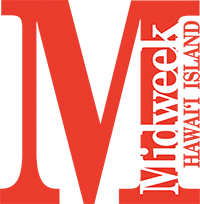Let There be Lights
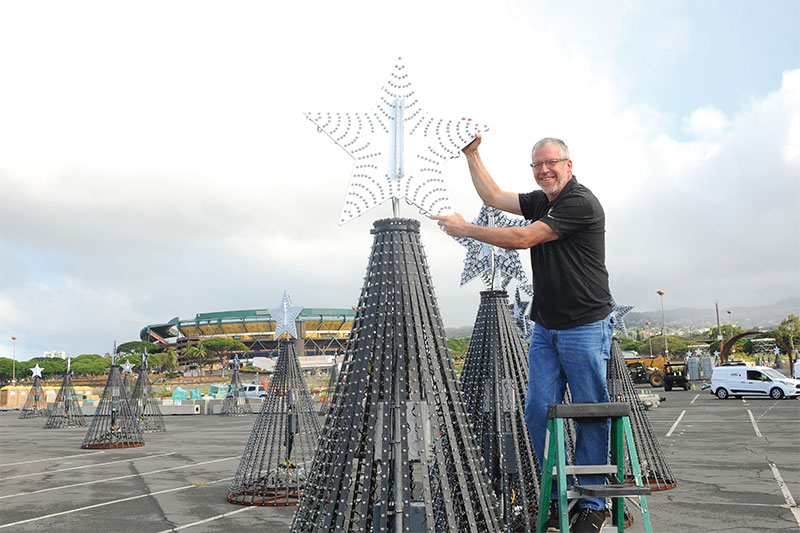
Michael Gangloff gets ready to turn on the power for 44 straight nights of dazzling Christmas lights during the upcoming holiday spectacle Show Aloha Winter Wonderland.
If there is one thing Michael Gangloff refuses to do, it’s to wake up on the wrong side of the bed. No matter how bad things may be going or how little sleep he’s getting, he always makes it a point to greet the day’s first light with a blast of his infectious aloha attitude.
Truth is, he can’t help but be positive and want to share his zest for life and all that he possesses with others. It’s just how he’s wired.
As he explains when describing his approach to each morning, “Every day I wake up, I tell myself, ‘Mike — damn! It’s gonna be a good day!’”
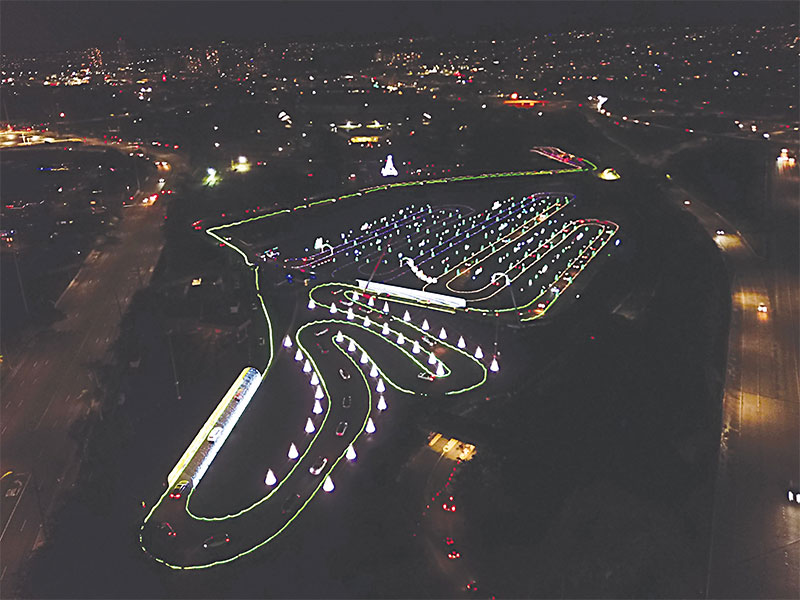
An aerial view of last year’s light show at Aloha Stadium, where 45,000 cars came during the event’s six-week run.
PHOTO COURTESY MICHAEL GANGLOFF
That refreshing perspective figures to be on full display when Gangloff and his team of volunteers literally begin lighting up the lives of those looking for a bit of hope and happiness in an often gloomy COVID world.
As the creator of the second annual Show Aloha Winter Wonderland — a 44-night-long Christmas-themed extravaganza that kicks off Nov. 19 and ends Jan. 1 at Aloha Stadium — Gangloff is intent on once again treating tens of thousands of island residents and visitors to some much-needed holiday cheer.
“What we’re doing with Show Aloha is creating an event where families can have a night out together in a comfortable, safe environment,” explains the man who’s been getting very little shut-eye lately because he’s working 18-hour days, plotting for a show that in part calls for at least 7 miles of Christmas lights and 15 miles of box tubing that will be shaped into arches and trees full of dazzling LEDs.
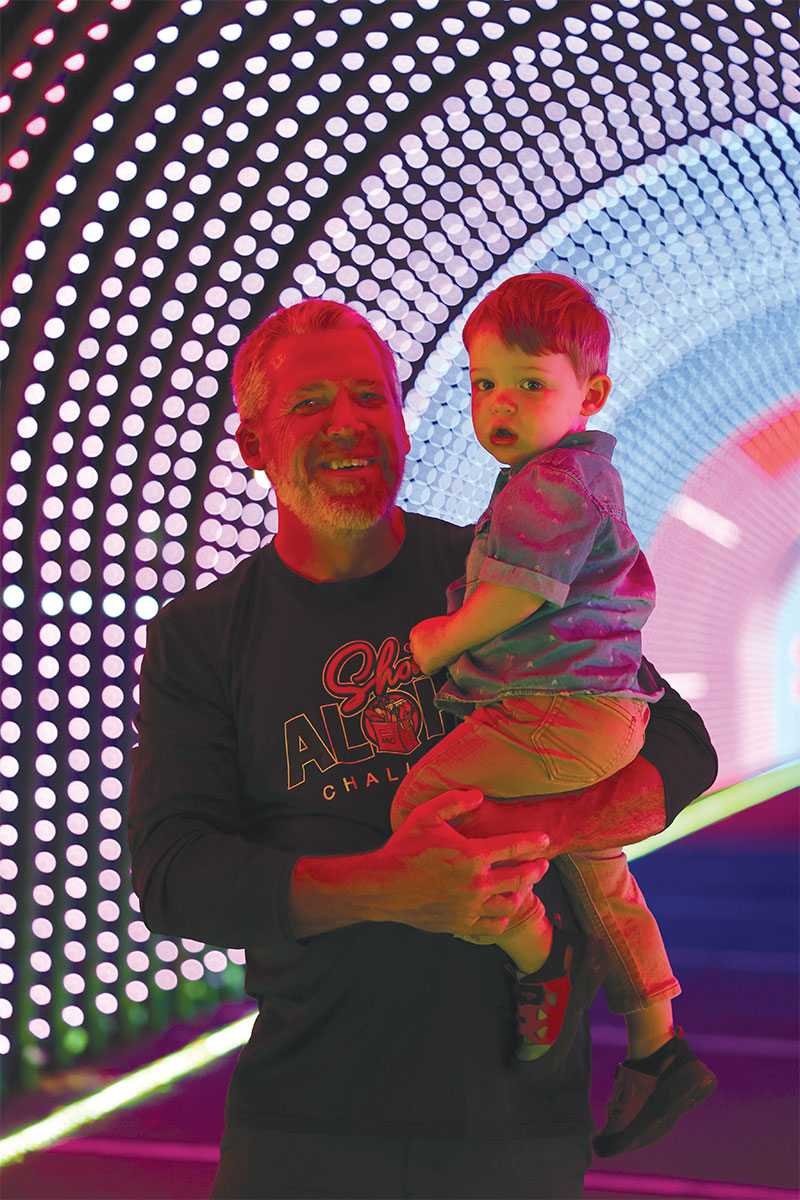
Michael Gangloff and son Xavier find a moment to bask in the lights of the walking tunnel, which will again be a featured attraction at Show Aloha Winter Wonderland, slated for Nov. 19-Jan. 1. PHOTO COURTESY ARYN NAKAOKA
Just as importantly, Mr. Positivity hopes “to rewire people’s minds” as well in the coming days and nights.
As he opines, “There’s a collective negative aura around us, and that aura is just building and building,” says Gangloff, who knows a thing or two about building structures as the owner and CEO of general contractor and event sponsor MIRA Image Construction LLC. “Right now, I don’t think we could be any more negative and that’s understandable with everything going on in the world.
“To me, the only way we can come back from this and be better and stronger is if we work together and put aside our petty differences.”
When he conceived the idea for last year’s show, Gangloff was unsure how he would turn his vision of a drive-thru spectacle replete with millions of lights into a reality.
But like a real-life Ray Kinsella, he knew that if he built it, people would come.
And come they did — in droves. Last year, the show drew 45,000 cars during its six-week run. This year, he’s hoping to attract 80,000 vehicles to an event that promises to be “twice as big.”
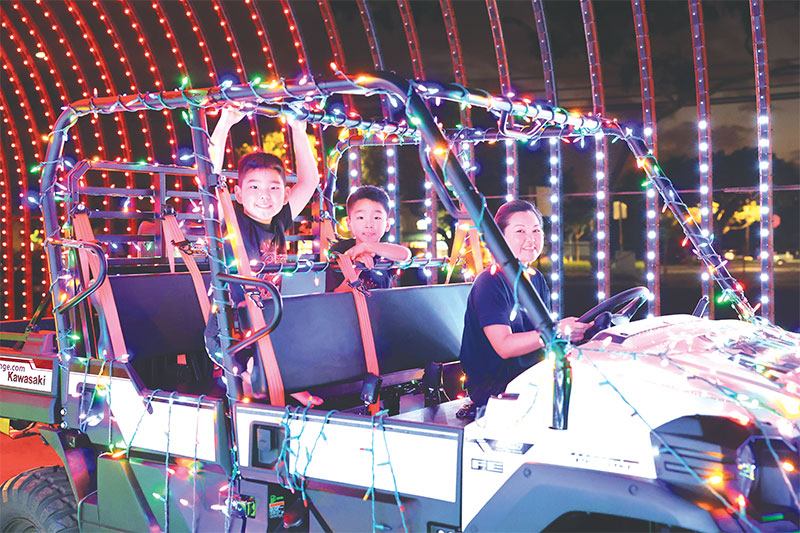
The Nakaoka ‘ohana — mom Darcie and sons Ryce and Ayce — enjoy their ride through one of the show’s lighted tunnels. PHOTO COURTESY ARYN NAKAOKA
In explaining some of the improvements planned for the upcoming show, he notes that last year’s two 150-footlong drive-thru tunnels will be twice as long in 2021. Additionally, the festive showcase will include a Santa’s photo shop for keiki, far more motifs and triple the number of Christmas trees (40 last year, 120 this year), he says.
Even the food court area has been expanded and will feature well-known vendors such as J. Dolan’s, Dippin’ Dots and Kettle Corn Hawai‘i.
And if all goes well, keiki attendees will be able to catch train rides during the show, even though current supply chain blockages are threatening to derail plans of adding two locomotives to the event.
“We all know there are shipping delays out there, but if I could somehow get the trains in by Dec. 6, I would be ecstatic because that would give the kids four solid weeks to enjoy the rides,” he says.
Finally, this year’s festivities will include a random drawing worth $200,000 in prizes. Those who purchase tickets to the light show will be automatically entered in the drawing, with the grandprize winner walking off with $50,000.
According to Gangloff, the beauty of his show is that while it certainly lifts people’s spirits with holiday cheer, it also delivers proceeds to several local charities, namely Make-A-Wish Hawai‘i, Kūpuna Power and Shriner’s Hospital for Children. Even his own foundation, Show Aloha Challenge, is a beneficiary of the annual light show, and uses funds raised to feed the hungry and create education hubs outfitted with computers for Hawai‘i’s seniors.
As another expression of his love for serving others, Gangloff and volunteers are scheduled to deliver approximately 2,900 turkeys — which he purchased for $35 each — to families in Mayor Wright Homes, Kūhiō Park Terrace and several other economically challenged communities. The deliveries will take place on the second day of the show, Nov. 20.
“I didn’t want these families to have to wait in some line for hours just to get a $35 turkey, so I thought if I took it to them, we wouldn’t have to worry about people not getting one if they got there late,” he says. “The turkey delivery isn’t necessarily a part of the light show, but it’s a part of the different facets of my Show Aloha Challenge foundation.”
No one would ever have blamed Gangloff if he had chosen the path of negativity in his youth. Certainly, there were ample reasons for him to have done so.
Born in Creve Coeur, Missouri, he and his family moved to the islands when he was 4. His biological father was not a part of his life, so parenting responsibilities fell to his mother, Judy, and stepfather Paul Moniz.
The family was financially strapped and survived mostly on government-assistance programs and whatever money Moniz would bring in from working multiple jobs.
Despite his poverty-stricken circumstances, Gangloff learned the value of hard work early on, and credits the example set by his stepfather.
“He worked his ass off to support us. I mean he had four jobs and would get there on a moped — it was ridiculous,” recalls Gangloff, the youngest boy in a family of three half-brothers and one half-sister.
“But he’s the reason I work my ass off because he’s the one I watched all my life.”
Gangloff was about 7 when he decided to start earning some money. At the time, the family was living in a low-income apartment complex in Waipahu, so he cooked up the idea of going door to door and asking residents if they would give him a penny for each bag of trash he hauled away. Many tenants gladly took him up on his offer rather than drag their refuse down the stairs.
With a few coins in his pocket, Gangloff would then wait for the manapua wagon to roll by.
“I could get two bubble gums for 1 cent. And if I had 5 cents, I could get one soda, or I could buy two (Charms) Blow Pops,” he says, chuckling at the memory.
Soon, he set his sights on bigger money-making ventures. By hanging out at Honolulu International Airport in the ’80s, for example, he found he could make 25 cents for each passenger baggage cart he returned.
“I would follow the passengers after they checked in, and because they couldn’t take the carts beyond security, I would be right there to take the carts away for them,” he explains. “Four or five bucks later, I now had enough money to go to Fun Factory!”
But while Gangloff was busy learning how to earn cash, he was also being exposed to the cruel realities of living in some of the roughest neighborhoods on O‘ahu.
As he recalls, “I was bullied constantly because of my white-color skin. When I was a freshman at Farrington, I would be playing basketball and somebody would do a layup and I would say, ‘Nice shot.’ And the guy would come over and punch me in the face.”
Despite his share of painful and unjust experiences, Gangloff refused to let them poison his view of humanity. A graduate of Farrington High School, he returned to his alma mater in recent years after he was asked to renovate a pair of its classrooms. He says the projects cost him about $100,000 out of his own pocket, but the money and time spent were well worth it because he not only believes “in doing what’s right,” but he also receives “immense joy in helping others.”
“People might ask why I do so much when I was treated that way. The fact of the matter is I see myself standing up for the underdog, for the person who cannot defend himself,” Gangloff explains. “When I do what I do, I believe I’m just doing what I really felt other people should have done to me. I’m being the opposite person of how I was treated.
“But make no mistake of it, there were people that were there for me along the way; there were plenty of people who made a huge difference and did help me, so I’m not grumbling about my childhood,” he adds.
“In fact, I would not change one iota of it.”
Gangloff may have inherited his work ethic from his stepfather, but he got his heart from his mom. In recent years, that heart has been further softened and shaped by his wife, Joy.
In recalling the weeks leading up to the 2020 light show, he remembers lying in bed with her one morning and wondering if she would be willing to make a sizeable sacrifice. At the time, the couple had saved a half-million dollars to buy a home. Knowing that the show would be in jeopardy if he wasn’t able to purchase a key item, Gangloff decided to ask his wife the unthinkable.
“I said, ‘Eh, hon, I was wondering if I could buy some things for the show with our savings? We’ll get our money back — I’m sure we will,’” remembers Gangloff. “And without hesitation, she said, ‘Yeah, hon. Go ahead. Let’s do it’ — and we literally stopped looking at homes right after that.”
So what exactly did he buy with the money he and his wife had saved for a home?
“I spent it on Christmas lights,” he confesses.
Of course Gangloff did. It’s just how he’s wired.
